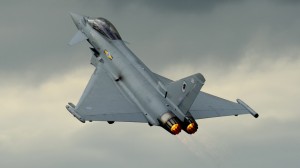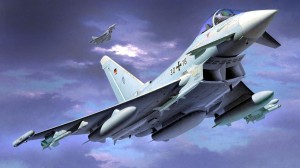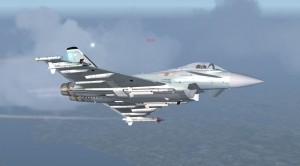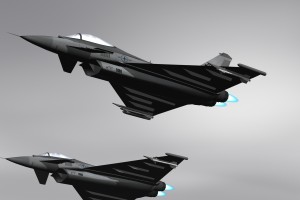Eurofighter Typhoon Facts
The fighter plane that is so advanced it can’t be flown by a human without the help of a computer.
The Eurofighter Typhoon may be the world’s most advanced killing machine, but it is also an extraordinary symbol of peace and cooperation. After centuries of fighting, a handful of European countries came together to produce this incredible aircraft.
From a plan that started way back as 1979, the Eurofighter was developed by Germany, Italy, Spain and the UK (France was involved for a while but then snuck off to do its own thing), and production is split between the four countries. At present there are plans to produce no fewer than 707 examples of the fighter jet. As well as the four core countries, the plane is also being used by other air forces around the world, including those of Austria, Saudi Arabia and Greece.
Why? Because it’s quite simply the most technologically advanced fighter jet on the planet, and also the most capable.
It’s what’s known as a swing-role weapon system, which means that it is capable of different operational tasks and can even switch from one duty to another on a single mission. For instance, it can be used as an air-to-air (short and medium range) fighter to gain all-important air superiority, while at the same time carrying large, long-range ground-attack weapons for taking out an enemy’s air defence systems.
 This flexibility is further enhanced by the plane’s incredible flying prowess. It boasts STOL (short take-off and landing) which means that it needs just 700 metres to take-off or land (the 747 you go on holiday in requires over 3,000 metres).
This flexibility is further enhanced by the plane’s incredible flying prowess. It boasts STOL (short take-off and landing) which means that it needs just 700 metres to take-off or land (the 747 you go on holiday in requires over 3,000 metres).
More impressively, the Eurofighter is incredibly manoeuvrable. This is thanks in part to its “relaxed stability’ design, which is a reassuring way of saying that the aircraft is inherently unstable, especially at subsonic speeds. Put simply, the plane’s delta wings and small fore fins create a pressure (lift) point which is forward of the centre of gravity during subsonic flight. And that means it is impossible for a human to fly the plane without the aid of a complex computer system that makes constant adjustments to the wings’ flaps quicker than the pilot could. Once the speed of sound is broken, though, the pressure point moves back and the aircraft becomes much more stable (although the computer aids remain).
 The same flight control systems also make the Eurofighter surprisingly easy to fly, therefore freeing up the pilot to concentrate on tactical tasks.
The same flight control systems also make the Eurofighter surprisingly easy to fly, therefore freeing up the pilot to concentrate on tactical tasks.
No wonder the Eurofighter Typhoon is changing the way the world’s air forces think about fighter planes.
What makes the Typhoon so formidable?
ARMED AND READY FOR ACTION
The Eurofighter’s formidable arsenal. The large items are, in fact, fuel tanks, although long-distance missiles can be fitted. The yellow devices are laser-powered bombs, while the smaller grey items are short-range air-to-air missiles. The thin armaments visible at the back of the fuselage are beyond-visual-range air-to-air missiles. There is also a Mauser BK-27 automatic cannon.
![Eurofighter armed Eurofighter armed]() SMALL BUT PERFECTLY FORMED
SMALL BUT PERFECTLY FORMED
The Eurofighter is remarkably compact – look at the size of the pilot in the cockpit to get an idea. The wingspan is 10.95 metres (less than that of a WWII Spitfire) and the length is 15.96 metres. This helps the aircraft to be incredibly agile, allowing it to change direction fast, as well as accelerate at an astonishing rate.
GIVING IT FULL THROTTLE
The Eurofighter’s twin Eurojet turbofan engines combine a jet nozzle with a ducted fan. This allows efficiency at low speeds combined with relatively quiet operation. They are equipped with afterburners (shown in operation here) which inject neat fuel into the jet stream to give a short increase in power. However, the Eurofighter can cruise at supersonic speeds without afterburner help.
Eurofighter facts
 Radar – Advanced ECR-90 radar can track multiple targets at long range.
Radar – Advanced ECR-90 radar can track multiple targets at long range.
Fore wings – Made from titanium, these aid agility and responsiveness.
Ejector seat – Pilot can eject from the plane at speeds of up to 600 knots.
Twin seat – A special twin-seater Eurofighter is used for training.
Stealth fuselage – A low frontal cross-section and the use of carbon fibre (70 per cent) and glass reinforced plastics (12 per cent) help ensure the Eurofighter can avoid detection by enemy radar. Metals, mostly aluminium and titanium, make up just 15 per cent of the body.
Weapons – There are 13 external weapon stations on the underside.
Joystick – The Hands on Throttle and Stick (HOTAS) is a single joystick that gives fingertip control of up to 24 functions, including throttle, manoeuvring, target manipulation and weapon control.
Cockpit – The high-tech cockpit is designed to make life easy for the pilot. Many functions are controlled by voice, while a heads-up display puts essential data right in front of the pilot.
Engines – Two EF200 turbofan engines are four metres in length and produce up to 90KN of thrust each. The simple construction ensures low maintenance, while there is future potential to increase power by up to 15 per cent.
Fuel systems – Fuel is stored in three tanks in the fuselage, a tank in each wing plus drop-tanks hung below each wing. An additional central drop-tank can be hung under the fuselage. When fully fuelled, the Eurofighter more than doubles in weight to 23,500kg.


